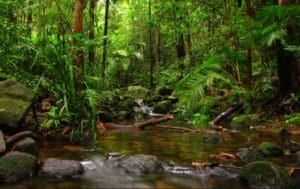In this vast world, many plants have yet to be appreciated for their interesting qualities, properties or health benefits. While it’s common knowledge that plants create the very oxygen we breathe, most people don’t know the immense number of plant species that have healing and nutritional properties. Here just a few interesting plant facts that you may not have known:

Image courtesy of www.thinglink.com
Only 1% of rainforest plants have been studied for medicinal purposes.
Medicinally, plants are incredibly valuable. The rainforest could be considered an untapped resource for a host of possible cures for ailments, holding a key to medical breakthroughs. In fact, this 1% represents more than 70,000 plant species that are currently being used for medicine.
While the Earth has more than 80 species of edible plants, 90% of the foods humans eat come from 30 plants.
Of the thousands of plants mankind could eat, we choose to eat only about 37% of the available edible plants. It is interesting how limited our diets are in comparison to all the foods we could be eating.

Image courtesy of www.hughesbrennanwirtz.com
Nutrition is not a crucial factor in the crops we mass-produce.
Unfortunately, nutrition is not the deciding factor in the crops that are mass-produced by farmers. The world’s largest agricultural exporters pursue certain crops because they can turn a profit, faster. These crops can be grown quickly, easily and inexpensively, making them a more profitable choice.
The California redwoods and sequoia are the largest and tallest living organisms in the world.
Known as “Nature’s Skyscrapers,” these massive trees can grow to be more than 250 feet tall and 30 feet in diameter. Located in Sequoia and Kings Canyon National Park is the world’s largest tree, named General Sherman, reaching 275 feet in height and weighing in at an astounding 4.19 million pounds! (How, exactly, does one weigh a tree? A topic for another blog, perhaps…)
80% of the original forests on Earth have been cleared or destroyed.
Four-fifths of the forests that covered the Earth over 8,000 years ago are all but gone. How many plant species have been lost due to human involvement? We may never know.

Image courtesy of www.global-worldissues.weebly.com
Two-thirds of the Earth’s plants are in danger of extinction.
Many plants’ natural habitats are being destroyed, making them vulnerable to extinction. Scientists have only examined a fraction of known plant species and concluded that many plants face extinction in the very near future.
Plant species are becoming extinct considerably faster than they should.
Human interference is causing our plant population to wilt rapidly making climate change and deforestation the biggest factors in plant extinction. Scientists believe that plants are dying off 1,000 to 10,000 times faster than they should naturally.

Image courtesy of www.timetravelturtle.com
The oldest botanical garden in the world in Padua, Italy, still preserves its original layout.
The Botanical Garden of Padua is the original European botanical garden, and is the birthplace of botanical science and understanding of the relationship between nature and culture. It consists of a circular central plot, symbolizing the world, surrounded by a ring of water.
More than half of all known plant species are native to no more than one.
Most native plants found in one part of the world are most likely not found anywhere else. When compared to the rapid decline in available plant species, there is little hope that one species could be found and harvested elsewhere or in different climates.

Image courtesy of www.write2rest.blogspot.com
During the middle 1600s, tulips were considered so valuable in Holland that they were worth more than gold!
After the flower was introduced to the Dutch from Turkey, it contracted a nonfatal virus known as mosaic. Rather than kill the tulip, the virus produced bright “flamelike” colors on the petals. The flower, which was already selling at a premium, skyrocketed in price, increasing in scarcity and demand! The craze caused the crash of the Dutch economy and was known as “tulip mania.”
